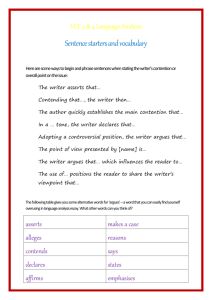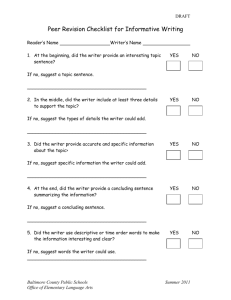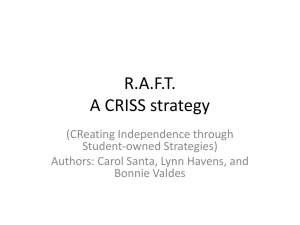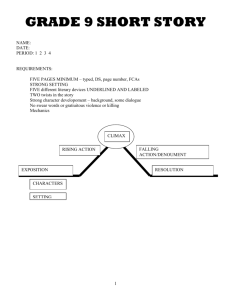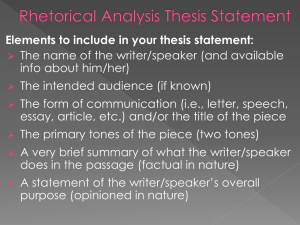Brainstorming Power: Inventing Your Topic, Thesis
advertisement
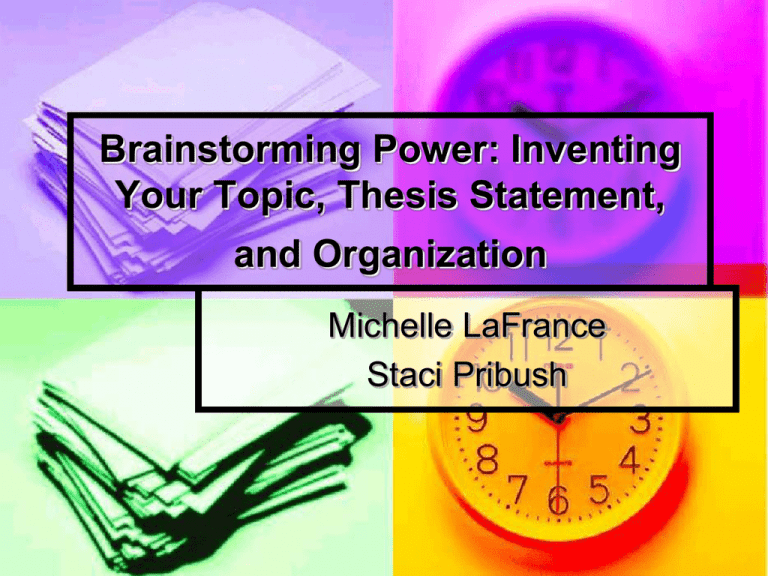
Brainstorming Power: Inventing Your Topic, Thesis Statement, and Organization Michelle LaFrance Staci Pribush Free Writing: Getting Something on the Page Also called “prewriting” (also see: “verbal vomit,” “info dump,” or “shutting off your brain”) this useful strategy/tool enables students to “discover” what they know by loosening up the invention process. To “free write” a writer will “dump” words onto the page without concern for getting the answer “right” or aptness of word choice, grammar, punctuation, expression. Once something is on the page the writer can then add to, extend, erase, complicate, correct, realign, etc. Free Writing Technique: Sit down at computer or with pencil and paper and just start writing down what you know, what you want to know, or what you want to say. Allow any thought, any word/sentence, etc slip from the brain to the paper. Getting words on paper is what counts. Some helpful tips: Natalie Goldberg’s recommendations: Give yourself a time limit. Write for one or ten or twenty minutes, and then stop. Keep your hand moving until the time is up. Do not pause to stare into space or to read what you've written. Write quickly but not in a hurry. Pay no attention to grammar, spelling, punctuation, neatness, or style. Nobody else needs to read what you produce here. The correctness and quality of what you write do not matter; the act of writing does. If you get off the topic or run out of ideas, keep writing anyway. If necessary, write nonsense or whatever comes into your head, or simply scribble: anything to keep the hand moving. If you feel bored or uncomfortable as you're writing, ask yourself what's bothering you and write about that. When the time is up, look over what you've written, and underline or circle the passages that contain ideas or phrases that might be worth keeping or elaborating on in a subsequent free-writing session. From: Writing Down the Bones Mind Mapping: Organizing Information A “Mind Map” is a form of non-linear diagramming that allows you to work with ideas visually or build a framework when you have a large amount of information. Allows writer to draw on intuition and multiple intelligences. Often begins with a central idea or image, and builds out from there, making connections, identifying or feeling out relationships, ordering and narrowing ideas. Can also help with problem solving and decision making. An Example of Mind Mapping Outlining: Following Your Own lead Definition: a preliminary draft or plan. Often taught as a series of statements ordered with letters and numbers Can simply be a series of sentence fragments and bullet points. This is your draft, it does not need to be pretty, happy, perfect, or lovable. Example of Recent Outline Discourse communities—processes of acculturation—are students helped by awareness of crossing between disciplinary communities? My writing—lot’s of struggle to become a professional writer— always told was a good writer—some professors seem to mark pet peeves instead of comments on content—what does that teach a writer? My film project—made me talk to people outside academia—could not talk about theory or readings/books—no shared vocabulary— made me learn to express very complex ideas in everyday language—this in turn made me really think about my language use—am I better writer now? Sometimes. Sometimes still want to reach for theory-babble.—now difference is that I’m more aware of myself as a writer. From first draft (in place of “thesis” statement): “I have no idea how I’m going to connect the relationship between the film project and my experience as a writer. Is there a point of realization I need to dig into—what is the story I want to tell?” Breaking it Down My film project: Bliadhna agus Lá —made me talk to people outside academia —I had no shared “theoretical” vocabulary with people I was talking to — made me change my approach because I could not talk about theory or readings/books —made me learn to express very complex ideas in everyday language —this in turn made me really think about my language use —am I better writer now? Sometimes. Sometimes still want to reach for theory-babble. —now the difference is that I’m more aware of myself as a writer. The Key Start with enough time that you can produce a really “crappy” draft. Let your draft “air.” That is, let it sit for a few hours, a day, a week. Revise! Rethink! Re-See! Still stuck? Take a walk, jump up and down, talk to a friend, come to the Writing Center. More Resources Purdue OWL: http://owl.english.purdue.edu/engagement/index.ph p?category_id=2&sub_category_id=2&article_id=53 University of North Carolina, Chapel Hill, Writing Center: http://www.unc.edu/depts/wcweb/handouts/brainstor ming.html University of Richmond Writing Center: http://writing.richmond.edu/writer/index.html



